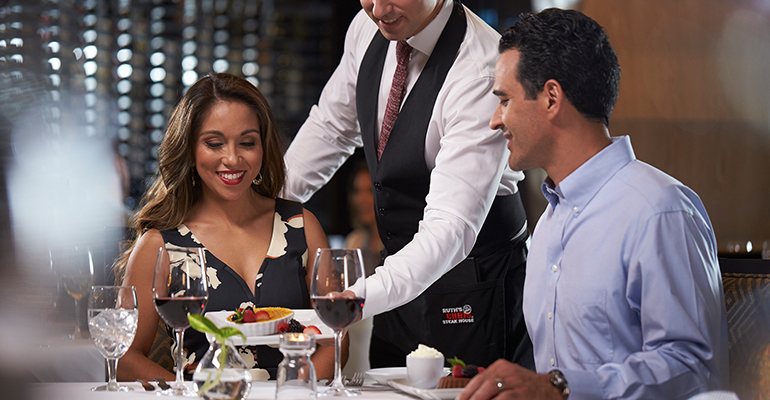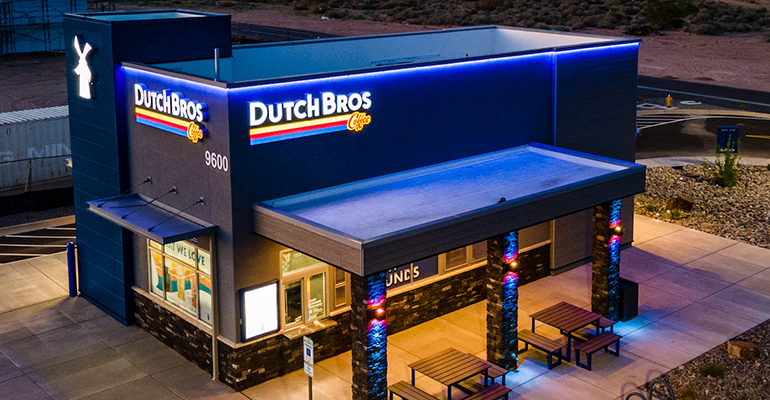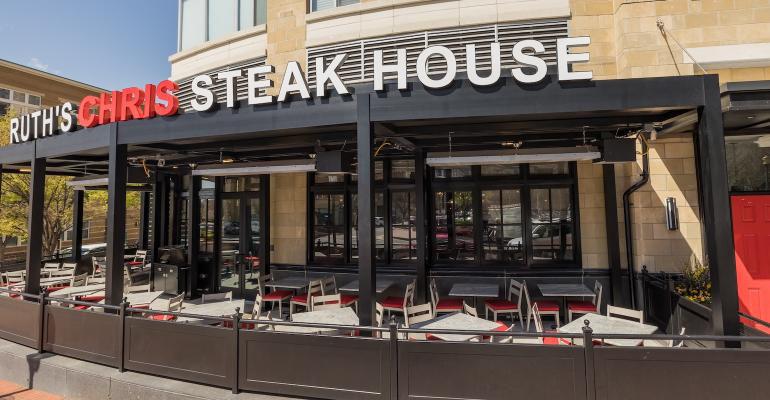Apparently, Americans really love their steak. And their coffee.
Neither should be a surprise on their own, of course. The U.S. is the largest consumer of beef in the world, while coffee is our second-most consumed beverage behind water. To further illustrate this point, consider that 63% of Americans have a cup of coffee every morning, while nearly two out of three Americans would choose beef as their last meal.
Perhaps that explains why two restaurant companies in two wildly different categories have emerged in the top three of America’s Favorite Chains, according to new data released from Technomic Ignite. Ruth’s Chris, a fine-dining steakhouse founded by Ruth Fertel in 1965 in New Orleans, garnered the highest accumulative score according to consumers, with 64.8%.
Coffee chain Dutch Bros, started in 1992 as a pushcart concept in Oregon, was third with a score of 60.3%. Dutch Bros was 0.1 percentage point behind No. 2, Seasons 52 (Ruth’s Chris’ sister brand at Darden), and 0.5 percentage points ahead of No. 4, steakhouse concept Fleming’s Prime.
Steak and coffee.
That said, Ruth’s Chris and Dutch Bros are popular for more than just our collective affinity for their signature offerings; there are certainly plenty of other steakhouses and coffeeshops that didn’t command the spotlight. For this particular data, scores are holistically derived, examining what consumers think about service and hospitality, unit appearance and ambiance, food and beverage, convenience and takeout, and value.
On paper, these two brands are more similar than one might think. Both have high marks for service, for instance, scoring the strongest of all brands. Notably, other surveys have also indicated strong service scores for both brands, including a recent HundredX and Forbes ranking of “2024 Best Brands for Customer Service.” Out of 300 brands on that list — based on over 4 million pieces of consumer feedback on over 3,000 businesses during the past year — Dutch Bros was in the top 10 and Ruth’s Chris was in the top 50. Further, Dutch Bros has been a perennial favorite for customer satisfaction by J.D. Power and Associates, while Ruth’s Chris was a top three brand in the upscale chain restaurant category for Newsweek and Statista’s 2023 “America’s Best Customer Service” rankings.
Want to dig deeper into America’s Favorite Chains? Follow the below links.
- Gen Z’s favorite restaurants
- Millennials’ favorite restaurants
- America’s favorite restaurants for burgers, chicken, pizza, and more
- What America’s favorite restaurant chains say about America
- America’s 10 favorite restaurant chains
Service may be the most unifying characteristic as measured by Technomic data, but zooming out a bit, these two brands have emerged as leaders because of their consistency across all categories.
“When we say favorite chains, we’re not asking ‘what’s your favorite chain?’ It’s an aggregation of brand performance rating. So, how are they performing, and in the context of the survey, everything is drawn back to the most recent occasion. If it’s consistent, that timing doesn’t matter,” said Robert Byrne, director of consumer and industry insights at Technomic. “When I think about these two brands, the fundamentals matter: quality service, a sliding scale of reasonable prices, and quality items I’m enjoying. Those two places never fail to deliver on those things.”
With that backdrop, let’s take a deeper look at how these two brands became America’s favorites.
Ruth’s Chris
Ruth’s Chris’ storied history started with Fertel, who spotted a local restaurant for sale in a classified ad. Against the advice of nearly everyone close to her, she mortgaged her house and bought the 60-seat Chris Steak House. Despite navigating a hurricane early on, the first several years were successful. Fertel differentiated the concept by developing a proprietary 1,800-degree broiler that replicated the sizzle from the first hot plate as the company scaled. Steaks are still cooked using that patented broiling method, and then served sizzling on 500-degree plates.
In 1976, a fire destroyed the restaurant and forced her to find a new location. Her contract, however, wouldn’t allow her to keep the original name, so Ruth’s Chris Steak House was born. She began franchising in 1976, buoying the concept into what it is today: a 147-unit upscale steakhouse with a footprint in 21 countries. In 2005, the company went public, and in June, it was acquired by Darden Restaurants for $715 million.
“When we consider adding a brand to our portfolio, we have set criteria,” Darden CEO Rick Cardenas said after the acquisition was announced. “The brand should be a full-service dining concept with strong guest appeal, have the ability to exceed the sales growth in our long-term framework and make an impact to our financial performance over time. Ruth’s Chris checks all these boxes.”
A Darden spokesperson reiterated Byrne’s point that the most significant driver of loyalty is Ruth’s Chris’ consistency of the guest experience.

In today’s economic uncertainty, “value” tends to be defined by service more than price.
Consistency, history, longevity, and expectations aside, it may seem counterintuitive for consumers to gravitate toward an upscale steakhouse during such wildly uncertain economic times as this, but that’s where perception kicks in. Ruth’s Chris scored the highest across segments for value, with 54.8% — higher than Jersey Mike’s, In-N-Out Burger, and Chick-fil-A.
Much of today’s “economic uncertainty” has been driven by stubbornly high menu prices, which have remained elevated despite overall inflationary cooling. In such an environment, “value” tends to be defined by service more than price, according to consumer strategist Lisa Miller.
“Sixty-five percent of consumers said they’re willing to pay higher restaurant prices when they know there will be exceptional service. People like to feel special, be cared for, and they’ll pay for it,” Miller said. “Ruth’s might be more expensive, but it’s worth it for many people because of that exceptional service.”
Another explanation for Ruth’s Chris’ favorable ranking comes from the simple fact that the chain is in the steak category. Indeed, Americans tend to gravitate toward beef in times of economic uncertainty as part of a self-care experience, which could in part explain why the cattle industry is seeing historically high demand for the protein, according to Agweek.
“For many people, steak is a reward and a treat, and in economic times when you’re making tough choices, you’re willing to splurge a little more for an experience and food type that makes it worth it,” Miller said. “You’ll leave feeling restored and taken care of, and that’s worth paying more for.”
Another draw could also simply be consumers’ pent-up demand for special occasion dining, where Ruth’s Chris is well positioned. According to OpenTable data, while year-round dining remained flat in 2023 versus 2022, special occasion dining grew materially. For example, Valentine’s Day and Mother’s Day business grew 9% and 6%, respectively, year-over-year, while diner spend grew by 15% versus non-holiday spend.
“We’re trading down everywhere except when it’s a special occasion. We’re going for what we want and we’re willing to spend money because it’s a special occasion. We’re happy to splurge in exchange for a bigger price-point commitment, so long as we’re getting service and flavor,” Byrne said. “Ruth’s Chris is not big on the newest, hottest, globally sourced trends. No, it’s the experience where you’re treated with a degree of quality or care and we’re willing to invest in that, no matter the age or cohort.”
That said, Ruth’s Chris is third for Gen Z with a score of 56.8% — behind Seasons 52 and First Watch. For millennials, it’s No. 1 by over three percentage points at 63.8%.
Across the board, Ruth’s Chris scored the highest in the unit appearance and ambiance category, with a 67.4% score, and the food and beverage category, with a 64.1% score. For the two remaining categories — convenience and takeout, and value — Ruth’s Chris was second, behind just Dutch Bros.
Dutch Bros
Dutch Bros also has a deep history, as well as longevity and strong expectations. The company finished 2022 with over $1.16 billion in sales and 671 locations. It now counts nearly 800 units with a long-term growth target of 4,000.
The concept was started 31 years ago as a pushcart by the railroad tracks in downtown Grants Pass, Ore., by brothers Dane and Travis Boersma, who left the dairy business to serve espresso, play music, and make connections with the community. Those connections resonated and Dutch Bros gained a loyal following that helped fuel its expansion. In 2000, the company opened its first franchised location.
The founders have made it their mission to make a “massive difference, one cup at a time,” and in 2006, they started hosting companywide givebacks to help support its communities and organizations. Simultaneously, Dutch Bros also began differentiating itself through exclusive drink creations, such as the Dutch Bros Blue Rebel energy drink, created by customers in 2012.
Sure, much of Dutch Bros’ growth has been driven by the convenience its off-premises-only model provides, and, unsurprisingly, the chain scored second overall for convenience (behind Jersey Mike’s). But its high scores for service and hospitality, facilitated by a culture that prioritizes its “broistas,” are also differentiating in an increasingly crowded category.
“Since the opening of our first shop, culture has defined the Dutch Bros experience. Our broistas and the connection they have with our customers set us apart from other brands. Whether customers are picking up an iced Carmelizer on their way to work or stopping for a Rebel energy drink in between classes, we make sure we’re delivering a great experience every time,” said Dutch Bros president and CEO Christine Barone. “Our broistas genuinely care about our customers and love to make their days better. Our drinks are fun and bring customers to the window, but it’s our culture and commitment to service that really sets us apart.”

Dutch Bros’ high scores for service and hospitality are differentiating in an increasingly crowded category.
Again, it may seem counterintuitive in an uncertain environment to find favor in something as discretionary as an iced Carmelizer, but Dutch Bros’ convenience and service combo provides compelling value.
“We either are or feel busier than we did before the pandemic, and these guys (Dutch Bros) are wildly convenient,” Byrne said. “So they’ve become part of a routine. And at a QSR service level only paralleled by Chick-fil-A or In-N-Out Burger, that price point becomes more affordable. Six or seven bucks for my favorite drink and infectious service? That becomes more palatable. That I can do.”
Miller adds that Dutch Bros’ focus on service makes the company feel more like a local coffeeshop, despite being a to-go concept. This is a critical balance to strike as more consumers — particularly younger consumers — want a positive, personalized experience with a brand, versus a transactional relationship.
“Consumers are craving that more than ever, and that’s why it’s just as important to invest in your people as it is your digital transformation,” she said.
Indeed, “friendly service” is more important than speed in her monthly QSR survey. Of note, Dutch Bros is the top overall quick-service brand in Technomic’s survey, nearly three percentage points ahead of No. 2 Tropical Smoothie. In the service and hospitality category specifically, Dutch Bros is 11.5 percentage points ahead of No. 2. It is also the highest scoring brand for Gen Z consumers.
Dutch Bros’ focus on service has long been ingrained in the company’s culture, but that doesn’t mean it’s resting on its laurels. In fact, Barone told analysts at Barclays’ recent Eat, Sleep, Play Conference that the company is in the “early stages of building a much bigger business” and will be able to do so because of its “people differentiation.”
“Our growth is predicated on our people. We have a robust pipeline of people who grew up in the company and really understand what it means to share the ‘Dutch Luv,’” she said.
To maintain that differentiation, the company has made significant wage investments, including changes to the shop manager pay structure.
“As we grow, we’ll continue to focus on our people and deliver an amazing experience, while identifying new ways to connect and innovate. Our philosophy from a labor perspective is always to be proactive. You never want to get behind in those places,” Barone said. “I think we have really happy team members. Every single thing we do, the first question we ask is, ‘Is this going to be a better environment for our broistas?’ When we have happy folks greeting customers, it’s the best place you can be.”
Apparently, Dutch Bros also has really happy customers, as evidenced by its tremendously popular Dutch Rewards program, which now generates nearly 65% of all transactions and features stickers that allow customers to personalize their app experience. Barone said the company is in the “very early innings” of what it can do with the program and is iterating some features to move toward more personalized offers.
“Across the country, customers say what amazing service we have, and the underlying strength behind that is our Rewards program,” she said. “Because we have so much data on customers, that gives us a runway to introduce people to new beverages that they would love but haven’t tried yet. This can drive frequency, activity at different dayparts, all types of things.”
Opposite sides of the spectrum
So long as consumers feel the need to reward themselves, the affinity for Ruth’s Chris and Dutch Bros could very well continue, including if the economy remains murky. This is especially true if both brands maintain their high service levels, as younger consumers have noted they are willing to pay more for better customer service.
“Right now, it’s all about high-end and snacks. Everything else in the middle is the stuff that’s getting snipped out of consumers’ occasions,” Byrne said. “High-end, special occasion and quick, convenient, small indulgence — these are the things that are easiest to enjoy. That’s the world consumers are living in right now.”
Contact Alicia Kelso at [email protected]
Methodology
Data for America’s Favorite Chains comes from Technomic Ignite Consumer, which collects information about how brands impact consumers and how consumers interact with those brands, via online survey. Respondents are shown the list of chains tracked and asked which they are familiar with, then how often they visit those chains. They are then randomly assigned one chain at which they have ordered a foodservice item in the past 30 (LSRs) or 60 (FSRs) days. Consumers then evaluate that chain on a variety of attributes based on their most recent occasion, providing details about their visit such as daypart, party composition, etc. Finally, they are asked about how important various attributes are in their decision to visit different types of restaurants. Percentages represent a composite top-box rating, indicating the share of recent guests who gave the brand the highest possible rating for each of the guest experience attributes. Each year, Technomic Ignite Consumer polls 112,000 nationally representative consumers ages 18-plus. Surveys are continuously fielded and data is compiled quarterly. Learn more about Ignite Consumer at www.technomic.com/ignite-consumer.
ABOUT TECHNOMIC
Technomic Inc., an Informa company, was founded as a management consulting firm in 1966. Since then, Technomic’s services have grown to encompass cloud-based B2B research tools, consumer and menu trend tracking and other leading strategic research and analytic capabilities, to prioritize and size business opportunities. Our clients include food manufacturers and distributors, restaurants, retailers and multiple other business verticals aligned with the food industry that are looking to make informed decisions to support their business growth. Visit Technomic at www.technomic.com.





